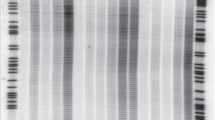Abstract
Ultrasonic fragmentation, which is a simple and convenient method for the mechanical degradation of DNA, is widely used in modern genome studies as one of the sample preparation steps. It has been recently found that the DNA breaks occur more often in the regions containing 5'-CG-3' dinucleotides. We studied the influence of the 5'-CG-3' dinucleotides on the efficiency of the 28S rRNA gene amplification during PCR with sonicated DNA of Mantis religiosa. It was shown that the amplification rate depends on the template length and the number of 5'-CG-3' dinucleotides. Amplification of the DNA regions with a higher 5'-CG-3' density is less efficient because of their higher sensitivity to ultrasound. The amount of the amplified DNA templates is inversely proportional to the 5'-CG-3'number.
Similar content being viewed by others
References
Ansorge W.J. 2009. Next-generation DNA sequencing techniques. N. Biotechnol. 25, 195–203.
Mann T.L., Krull U.J. 2004. The application of ultrasound as a rapid method to provide DNA fragments suitable for detection by DNA biosensors. Biosens. Bioelectron. 20, 945–955.
Elsner H.I., Lindblad E.B. 1989. Ultrasonic degradation of DNA. DNA. 8, 697–701.
Taub M.A., Bravo H.C., Irizarry R.A. 2010. Overcoming bias and systematic errors in next generation sequencing data. Genome Med. 2, 87.
Schwartz S., Oren R., Ast G. 2011. Detection and removal of biases in the analysis of next-generation sequencing reads. PLoS ONE. 6, e16685.
Benjamini Y., Speed T.P. 2012. Summarizing and correcting the GC content bias in high-throughput sequencing. Nucleic Acids Res. 40, e72.
Guo Y., Li J., Li Ch., Long J., Samuels D.C., Shyr Y. 2012. The effect of strand bias in Illumina short-read sequencing data. BMC Genomics. 13, 666.
Chen Y.-C., Liu T., Yu C.-H., Chiang T.-Y., Hwang C.-C. 2013. Effects of GC bias in next-generation-sequencing data on de novo genome assembly. PLoS ONE. 8, e62856.
Poptsova M.S., Il’icheva I.A., Nechipurenko D.Yu., Panchenko L.A., Khodikov M.V., Oparina N.Y., Polozov R.V., Nechipurenko Yu.D., Grokhovsky S.L. 2014. Non-random DNA fragmentation in next-generation sequencing. Sci. Reports. 4, 4532.
Packer M.J., Dauncey M.P., Hunter C.A. 2000. Sequence-dependent DNA structure: Tetranucleotide conformational maps. J. Mol. Biol. 295, 85–103.
Grokhovsky S.L. 2006. Specificity of DNA cleavage by ultrasound. Mol. Biol. (Moscow). 40 (2), 275–283.
Nechipurenko Yu.D., Golovkin M.V., Nechipurenko D.Yu., Il’icheva I.A., Panchenko L.A., Polozov R.V., Grokhovsky S.L. 2009. Characteristic features of DNA cleavage by ultrasound. Zh. Strukt. Khim. 50, 1045–1052.
Grokhovsky S.L., Il’icheva I.A., Nechipurenko D.Yu., Golovkin M.V., Panchenko L.A., Polozov R.V., Nechipurenko Yu.D. 2011. Sequence-specific ultrasonic cleavage of DNA. Biophys. J. 100, 117–125.
Grokhovsky S.L., Il’icheva I.A., Panchenko L.A., Golovkin M.V., Nechipurenko D.Yu., Polozov R.V., Nechipurenko Yu.D. 2013. Ultrasonic cleavage of DNA in complexes with Ag(I), Cu(II), Hg(II). Biophysics (Moscow). 58 (1), 19–26.
Grokhovsky S.L., Il’icheva I.A., Nechipurenko D.Yu., Panchenko L.A., Polozov R.V., Nechipurenko Yu.D. 2008. Heterogeneity of dounble-stranded DNA local structure and dynamics: Ultrasound studies. Biofizika. 53, 417–425.
Nechipurenko D.Yu., Il’icheva I.A., Khodikov M.V., Poptsova M.S., Nechipurenko Yu.D., Grokhovsky S.L. 2014. Modeling of mechanochemical DNA cleavage by the action of ultrasound. Biophysics (Moscow). 59 (6), 861–868.
Nechipurenko Yu.D., Nechipurenko D.Yu, Il’icheva I.A., Golovkin M.V., Panchenko L.A., Polozov R.V., Grokhovsky S.L. 2010. Conformational dynamic properties of DNA and approaches to physical genome mapping. Komp’yut. Issled. Model. 2, 419–428.
Larguinho M., Santos H.M., Doria G., Scholz H., Baptista P.V., Capelo J.L. 2010. Development of a fast and efficient ultrasonic-based strategy for DNA fragmentation. Talanta. 81, 881–886.
Hagerman P.J. 1981. Investigation of the flexibility of DNA using transient electric birefringence. Biopolymers. 20, 1503–1535.
Golenberg E.M., Bickel A., Weihs P. 1996. Effect of highly fragmented DNA on PCR. Nucleic Acids Res. 24, 5026–5033.
Garafutdinov R.R., Nagaev N.R., Sakhabutdinova A.R., Chemeris A.V. 2015. Authenticity, integrity, and accessibility of ancient DNA. Vestn. Bashkir. Gos. Univ. 20, 432–439.
http://www.ncbi.nlm.nih.gov/nuccore/
http://eu.idtdna.com/analyzer/Applications/OligoAnalyzer/
Koshikawa S., Miyazaki S., Cornette R., Matsumoto T., Miura T. 2008. Genome size of termites (Insecta, Dictyoptera, Isoptera) and wood roaches (Insecta, Dictyoptera, Cryptocercidae). Naturwissenschaften. 95, 859–867.
Author information
Authors and Affiliations
Corresponding author
Additional information
Original Russian Text © R.R. Garafutdinov, A.A. Galimova, A.R. Sakhabutdinova, A.V. Chemeris, 2016, published in Molekulyarnaya Biologiya, 2016, Vol. 50, No. 2, pp. 272–278.
Rights and permissions
About this article
Cite this article
Garafutdinov, R.R., Galimova, A.A., Sakhabutdinova, A.R. et al. PCR-based evaluation of sequence specificity of DNA fragmentation by ultrasound. Mol Biol 50, 236–241 (2016). https://doi.org/10.1134/S0026893316020059
Received:
Accepted:
Published:
Issue Date:
DOI: https://doi.org/10.1134/S0026893316020059




